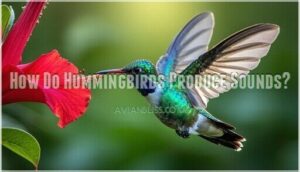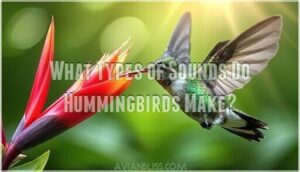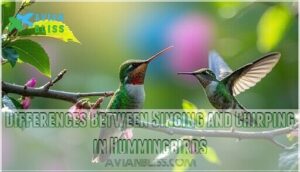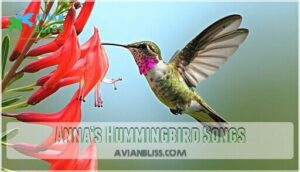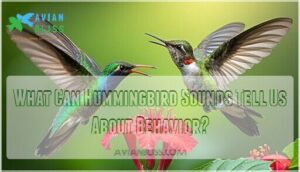This site is supported by our readers. We may earn a commission, at no cost to you, if you purchase through links.
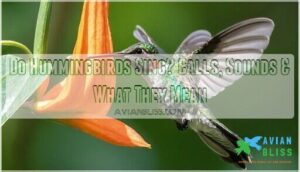 Do hummingbirds sing? Not quite like songbirds, but they’re anything but quiet. You’ll hear them produce chirps, chatters, and trills through their syrinx, though their vocal range is pretty limited compared to traditional songbirds.
Do hummingbirds sing? Not quite like songbirds, but they’re anything but quiet. You’ll hear them produce chirps, chatters, and trills through their syrinx, though their vocal range is pretty limited compared to traditional songbirds.
What’s fascinating is how they create two types of sounds: vocal calls for communication and mechanical sounds from their wings and tail feathers. Those signature buzzing and whistling noises aren’t just byproducts of flight—they’re intentional communication tools.
Males use these sounds during territorial disputes and courtship displays, while parents and chicks exchange specific calls during feeding time. Each species has its own unique sound signature, making identification possible through audio alone.
Table Of Contents
- Key Takeaways
- Do Hummingbirds Sing?
- How Do Hummingbirds Produce Sounds?
- What Types of Sounds Do Hummingbirds Make?
- Differences Between Singing and Chirping in Hummingbirds
- Why Do Hummingbirds Use Vocalizations?
- Hummingbird Species Known for Unique Sounds
- How Do Hummingbird Sounds Vary by Species?
- What Can Hummingbird Sounds Tell Us About Behavior?
- Frequently Asked Questions (FAQs)
- Do hummingbirds chirp or sing?
- Do hummingbirds make vocal sounds?
- Do hummingbirds remember people?
- What does it mean when a hummingbird comes close to you?
- Are hummingbirds born with the ability to make sounds?
- Can hummingbirds mimic other birds or animals?
- Do hummingbirds make sounds while they are sleeping?
- Can hummingbirds lose their ability to make sounds?
- Are hummingbirds more vocal in certain environments or climates?
- Can hummingbirds learn songs from other birds?
- Conclusion
Key Takeaways
- You’ll discover hummingbirds do sing, but their songs are much simpler than those of typical songbirds due to their tiny voice box called a syrinx, which limits them to basic chip notes, chirps, and trills rather than complex melodies.
- You can identify two distinct types of hummingbird sounds: vocal calls made through their syrinx for communication, and mechanical sounds created by their wings and tail feathers that produce the signature buzzing and whistling noises.
- You’ll hear different sounds serving specific purposes—males use structured songs during courtship displays and territorial disputes, while parents and chicks exchange calls during feeding time, with each species having its own unique acoustic signature.
- You can distinguish individual hummingbird species by their vocalizations alone, as each produces distinct frequency ranges, tonal qualities, and complexity levels that researchers use for identification in the field.
Do Hummingbirds Sing?
That distinctive buzz at your feeder isn’t just noise—it’s a mix of actual hummingbird vocal communication and mechanical sounds.
Hummingbirds do sing, though their songs are nothing like what you’d expect from other birds. With a syrinx smaller than a pinhead, their vocal complexity stays pretty basic—think simple chips and chatters instead of elaborate melodies.
During breeding season, males belt out their own versions of structured songs—though don’t expect anything as elaborate as what you hear from songbirds. Hummingbirds stick with what comes naturally, unlike many birds that pick up new tunes and develop local dialects over time.
Their repertoire stays pretty straightforward: repetitive chirps, chatters, and trills that get the job done.
Here’s what makes hummingbird sounds so fascinating: they’re actually a mix of vocal calls and mechanical noise. That signature humming? It’s all wing beats—their voice box has nothing to do with it.
Hummingbirds are remarkable because their familiar hum is created by rapid wingbeats, not their tiny voice box
But don’t underestimate their actual calls. These tiny chirps, chatters, and trills pack a punch when it comes to defending territory, attracting mates, and keeping the social order intact.
How Do Hummingbirds Produce Sounds?
Hummingbirds produce sounds in two distinct ways: through their syrinx (a miniature voice box) and from the mechanical vibrations of their rapidly beating wings and tail feathers.
Understanding how these small birds produce their distinctive vocalizations and wing-generated humming will help you identify what you’re hearing when these aerial acrobats visit your yard.
The Hummingbird Syrinx and Its Limitations
Hummingbirds pack their vocal equipment into an incredibly tiny package. Their syrinx – the bird equivalent of our voice box – is so small it creates real limitations on what sounds they can make.
This miniature anatomy puts serious constraints on their vocal abilities. While songbirds can produce elaborate melodies with their larger, more developed vocal systems, hummingbirds are stuck with simple chip notes and basic calls. Their size comes with trade-offs, and complex vocalizations didn’t make the cut.
Mechanical Sounds From Wings and Tail Feathers
Unlike vocal sounds, hummingbirds create mechanical sounds through feather vibration analysis during flight. Their wing feathers produce the signature whirring sound through aerodynamic sound production, beating 50-80 times per second.
Tail feathers generate clicking and whistling noises through species-specific mechanics. This wing sound physics creates the "hum" that gives these birds their name, demonstrating fascinating sound evolution in nature.
What Types of Sounds Do Hummingbirds Make?
Hummingbirds make sounds in two distinct ways: vocal calls produced by their syrinx (the bird equivalent of vocal cords) and mechanical sounds created by their rapidly beating wings and specialized tail feathers.
These small birds produce chip notes, trills, whines, scratchy calls, buzzing wing beats, and whistling sounds that serve different communication purposes.
Chip Notes and Chirping Calls
Chip notes represent the most common hummingbird sounds you’ll hear. These sharp, single-syllable chirps serve multiple functions in their behavioral repertoire.
- Chirp acoustic features: High-pitched frequencies ranging from 3-8 kHz with rapid delivery
- Chirp species variation: Each species produces distinct chip note patterns for identification
- Chirp behavioral context: Used during territorial disputes, feeding interactions, and social encounters
Unlike complex songs, these chipping calls are brief vocalizations lasting milliseconds. The chirp vs. song distinction becomes clear when observing their chirp note function – primarily communicating immediate needs rather than elaborate courtship displays.
Trilling, Whining, and Scratchy Calls
Beyond simple chirping sounds, you’ll hear trilling calls that are high-pitched and repetitive, often used for territorial defense. Whining calls represent food begging sounds from baby hummingbirds. Scratchy calls are staccato vocalizations made during flight.
These acoustic analysis patterns show behavioral contexts through call function and species variation in hummingbird sounds and vocalizations.
Buzzing, Humming, and Whistling Noises
You’ll encounter three distinct mechanical sounds that showcase hummingbird sound aerodynamics. These non-vocal noises result from wing sound aerodynamics and tail feather vibrations during flight:
- Humming sound – Created by rapid wingbeats (50-80 beats per second) producing species-specific buzzes
- Whirring sound – Generated when birds dive or maneuver quickly through flight noise variation
- Shrill wing whistle – Produced by specialized tail feathers in species like Broad-tailed hummingbirds for sound mimicry defense
Each species creates unique mechanical signatures you can identify.
Differences Between Singing and Chirping in Hummingbirds
Hummingbirds communicate through both songs and chirps, each serving distinct functions.
Their chirps are brief, simple calls for everyday interactions, while songs consist of longer, multi-syllabic sequences that males perform during mating season.
While chirps are short, simple calls used for quick interactions, songs are longer sequences with multiple syllables that males perform during breeding season.
Definitions and Examples of Each Sound
When examining hummingbird vocalizations, you’ll discover clear sound classifications that separate chirping from singing behaviors. Chirping involves simple chip notes—brief, high-pitched calls lasting milliseconds with basic acoustic properties. Bird songs feature complex vocal repertoire with varied syllables, longer duration, and intricate sound examples.
Species variations create distinct courtship song patterns, with Anna’s hummingbirds producing structured melodies while others emit scratchy calls or trilling sequences during hummingbird behavior displays.
Functions of Singing Vs. Chirping
You’ll hear different purposes behind hummingbird vocalizations. Singing complexity has courtship functions, with males producing elaborate sequences to attract mates. Chirping aggression signals territory defense and dominance displays.
Contextual variations show how hummingbird behavior adapts—alarm calls warn of danger while vocal learning helps young birds develop song dialects for their local communities.
Why Do Hummingbirds Use Vocalizations?
Hummingbirds rely on their vocal repertoire for three essential survival functions: warding off territorial invaders, wooing potential mates, and signaling their offspring when it’s feeding time.
These tiny birds rely on their chip notes, trills, and calls to survive in competitive environments where nectar sources and nesting sites are limited.
Territorial Defense and Aggression
Hummingbirds turn into tiny warriors when defending their turf. You’ll hear sharp chip notes and rapid-fire chattering as they chase intruders from feeders.
These territory vocalizations serve as sound intimidation, warning competitors to back off. During feeding battles, aggressive birds use alarm calls and hierarchy displays to establish dominance.
Their vocalizations reveal complex hummingbird behavior patterns in animal behavior studies.
Courtship and Mate Attraction
During mating season, males perform elaborate courtship displays combining aerial acrobatics with specialized courtship songs. These vocal duets help females assess male quality, with sound evolution favoring complex vocalizations.
Courtship behaviors include synchronized flights and distinctive calls that demonstrate fitness. Animal mating strategies rely heavily on these acoustic signals for successful reproduction.
Parental Care and Food Begging
Beyond courtship rituals, you’ll notice young hummingbirds use distinct vocalizations for survival. Nestlings produce whining calls that trigger immediate parental response cues. These food demand signals showcase striking begging call acoustics that parents can’t ignore.
- Nestling sound development begins within days of hatching
- Fledgling vocalizations intensify when parents approach with food
- Chipping calls signal hunger levels to attentive adults
- Parental response cues assure efficient feeding coordination
These hummingbird vocalizations demonstrate intricate avian behavior and animal communication systems.
Hummingbird Species Known for Unique Sounds
Different hummingbird species create their own unique sound profiles that make them easy to identify.
Anna’s Hummingbirds create structured songs with complex syllable sequences, while Broad-tailed Hummingbirds generate sharp wing whistles and Red-billed Streamertails produce characteristic whirring sounds during flight maneuvers.
Anna’s Hummingbird Songs
Anna’s hummingbirds stand out as vocal superstars among their species. These birds produce buzzy songs lasting over 10 seconds, combining whistles, buzzes, and emphasized chip notes with striking complexity. Males perform impressive courtship dives from 130 feet up, creating explosive squeaks through specialized tail feathers. Their display chirps hit frequencies around 4 kHz—similar to musical note C8.
The species’ conservation status is currently listed as Least Concern. You’ll hear regional dialects as these hummingbirds adapt their vocalizations through song learning across different territories.
Broad-tailed and Red-billed Streamertail Whistles
Two species create fascinating whistle acoustics through specialized feather modifications. Broad-tailed hummingbirds produce metallic trills using modified wing feathers with narrow gaps, while Red-billed Streamertails generate 858 Hz pulsed tones synchronized with their wingbeats.
These aerodynamic whistles serve dual purposes in courtship displays and territorial defense, showcasing how whistle evolution shaped unique acoustic signals in broadtailed hummingbird species and their tropical relatives.
Rufous and Costa’s Hummingbird Calls
Rufous hummingbirds produce rapid warning chip notes and distinctive "chu-chu-chu-chu" sounds during courtship dives. Male Costa’s hummingbirds create high-pitched tones through both vocalizations and tail feather sonation.
Costa’s males perform displays ending with sounds directed at females via 90-degree feather swivels. These acoustic signals help distinguish species through unique call comparison patterns and regional dialects.
How Do Hummingbird Sounds Vary by Species?
Each hummingbird species carries its own distinctive vocal fingerprint – unique frequency ranges, tonal qualities, and complexity patterns that allow researchers to identify them through sound alone.
These species-specific differences in pitch, rhythm, and syllable structure make it possible to identify individual species by their calls alone, even when you can’t see the bird.
Frequency, Tone, and Complexity Differences
Each hummingbird species produces distinct sound frequency ranges that help identify them. Vocal tone variations span from less than 1 kHz to over 10 kHz, with some Black Jacobin vocalizations reaching ultrasonic levels.
Call complexity levels differ dramatically—vocal learning species show higher tonality averaging 26.8 dB compared to non-learners at 12.9 dB. These species-specific acoustics create unique sound identification keys for researchers studying bird songs and vocalizations; for example, the Ruby-throated Hummingbird is known for its distinctive chee-dit call.
Identifying Species by Their Vocalizations
Experienced birders can distinguish hummingbird species through their unique vocalizations. Each species produces distinct calls, ranging from Anna’s loud chirps to Broad-tailed’s shrill whistles. Vocalization complexity varies greatly, with some species even displaying regional dialects.
Sound mimicry is rare, though hybridization effects can blur acoustic boundaries. These bird songs enable reliable identification when visual cues fail.
What Can Hummingbird Sounds Tell Us About Behavior?
When you listen to hummingbird vocalizations, you’re hearing a complex communication system that reveals their territorial disputes, mating intentions, and feeding behaviors.
Each chirp, trill, and chatter provides clues about whether they’re defending a prime nectar source, courting a potential mate, or signaling aggression to competitors.
Interpreting Calls and Songs in The Wild
When you’re watching hummingbirds, decoding birdsong becomes easier with practice. Listen for behavioral context clues that reveal what’s happening. Acoustic monitoring helps with bird sound identification and understanding avian communication patterns.
- Sharp chip notes during chases – signals territorial disputes and aggressive encounters
- Soft trilling near feeders – indicates calm feeding behavior or social interactions
- Complex vocalizations at dawn – suggests courtship displays or territory mapping activities
These hummingbird vocalizations tell stories about their daily lives and social dynamics.
Using Sounds for Bird Watching and Research
Learning bird sounds makes all the difference when you’re out watching. Good recording gear and apps that analyze sounds let you capture hummingbird calls for research projects.
Your observations contribute to citizen science projects, supporting conservation applications. Wildlife sounds recorded during fieldwork provide data for researchers studying hummingbird behavior and communication patterns across different species and habitats.
Frequently Asked Questions (FAQs)
Do hummingbirds chirp or sing?
You’ll hear their tiny voices create delicate musical phrases, not just simple chirps. Hummingbirds produce both vocalizations: males sing complex songs during breeding season, while both sexes make high-pitched chirping calls for communication and territory defense throughout the year.
Do hummingbirds make vocal sounds?
Hummingbirds actually do vocalize through their syrinx, a tiny voice box that creates surprisingly sharp chip notes and chirps.
During breeding season, some species take it further with actual structured songs.
Do hummingbirds remember people?
Hummingbirds can recognize individual humans through visual cues and impressive memory skills that rival primates. They remember who feeds them regularly and alert people when feeders need refilling by hovering near their heads.
What does it mean when a hummingbird comes close to you?
When you’re approached by a hummingbird, it’s likely investigating you as a potential food source or perceived threat.
They’re naturally curious creatures with poor eyesight, so they’ll hover close to examine bright colors, floral patterns, or anything resembling nectar sources on your clothing.
Are hummingbirds born with the ability to make sounds?
Baby hummingbirds aren’t born with sound-making abilities. They develop vocal skills gradually through practice and neural maturation.
Young birds start with basic chip notes, then learn more complex calls by mimicking adults around feeders.
Can hummingbirds mimic other birds or animals?
Unlike songbirds, you won’t hear hummingbirds mimicking other species. Their tiny voice box limits them to simple chip notes and calls, lacking the complex vocal apparatus needed for mimicry like mockingbirds possess.
Do hummingbirds make sounds while they are sleeping?
Like silent sentinels in nature’s quiet hours, you won’t hear hummingbirds vocalize during sleep. Their metabolic processes slow dramatically, suppressing vocal activity.
They’re pretty much in torpor-like states, conserving energy through reduced physiological functions.
Can hummingbirds lose their ability to make sounds?
Yes, you can observe hummingbirds losing their vocal abilities due to injury, illness, or aging.
Their tiny syrinx becomes damaged from infections or trauma, affecting their chip notes and territorial calls permanently.
Are hummingbirds more vocal in certain environments or climates?
Hummingbirds get chattier when they’re looking for mates and in areas where competition for territory heats up. They’re especially vocal around feeders and wherever flowers are plentiful.
Can hummingbirds learn songs from other birds?
Researchers have discovered that hummingbirds can learn songs from others. Seven of eight birds that heard Costa’s-like songs learned to sing their tutor song, demonstrating vocal learning abilities similar to songbirds.
Conclusion
Understanding hummingbird vocalizations opens a window into their complex social world. Whether you’re observing territorial disputes at your feeder or listening to courtship displays in your garden, recognizing these sounds enhances your birdwatching experience.
While the question "do hummingbirds sing?" reveals they’re not traditional songbirds, their diverse acoustic repertoire has important survival functions. Next time you hear that familiar hum, you’ll appreciate the well-developed communication system these tiny birds have evolved.
- https://pubmed.ncbi.nlm.nih.gov/35073546/
- https://www.allaboutbirds.org/guide/Annas_Hummingbird/sounds
- https://journeynorth.org/hummingbirds/resources/article/facts-hummingbird-characteristics
- https://karger.com/bbe/article/97/3-4/241/821569/Vocal-Communication-in-Hummingbirds
- https://www.sciencedirect.com/science/article/pii/S0960982218309886

